Class, Race, and Cattle (I)
Up to and including this moment, every man has been domesticated into his present role. We are born with certain adaptations to our parents’ circumstances, forced to adapt to our own in order to survive. Luckily, survival has never been easier. Unfortunately, it’s never been so complex, so dynam…
Keep reading with a 7-day free trial
Subscribe to Ținând de Mâinii Strigoii-lor to keep reading this post and get 7 days of free access to the full post archives.



